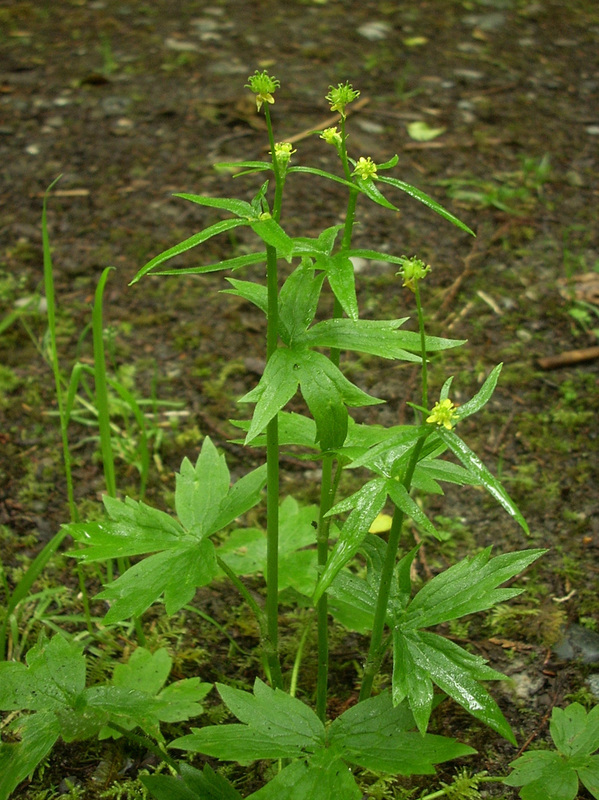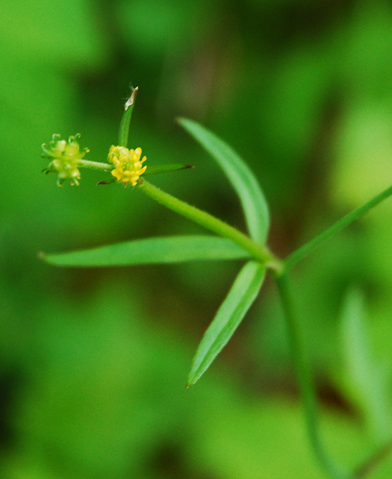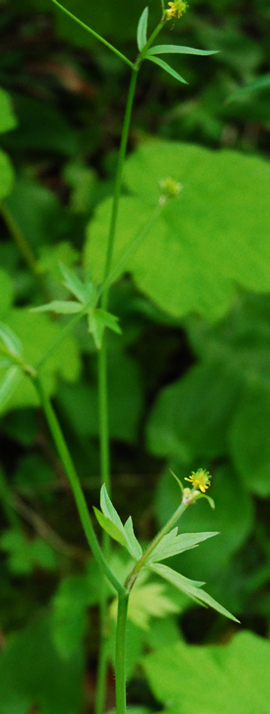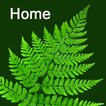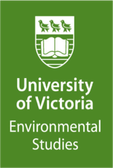Little buttercup, woodland buttercup • Ranunculus uncinatus
Identification
Little buttercup is a lanky, leafy single-stemmed plant that can be an annual or a perennial. Its stems, which are usually unbranched, are hollow and grow to 90 cm tall. It bears very small yellow flowers, which have five petals and grow individually on stalks. Clusters of these stalked flowers grow at the top of the stem above long and narrow leaf-like bracts. Most of the leaves grow on long stalks from the base, while a couple grow along the stem. The basal leaves are divided — sometimes quite deeply — into three lobes, each of which is again divided and toothed; the stem leaves are even further divided and have a transitional shape between the lower leaves and the upper leafy bracts. This plant bears small clusters of seeds with distinctive hooked tips.
Habitat & Range
This common plant can be found in a variety of low to mid-elevation habitats, from meadows, streamsides, and beaches to shady and moist woodlands. It is also found in disturbed areas such as along trails. It is found throughout much of western North America, with a coastal range extending from Alaska to California.
Similar Species
The general tall, leafy, and lanky appearance of large-leaved avens (Geum macrophyllum) could cause some confusion with little buttercup, especially as the two are found in similar habitats. A closer examination of basal leaf shape (those of large-leaved avens are toothed but not divided) and flowers (little buttercup flowers are smaller) should resolve any confusion, however.
Intriguing Info
The hooks on the seeds help with dispersal by clinging to passing animals that brush up against the plants. This applies to humans too: if you pass by little buttercup, you may later find the seeds clinging to your socks or pant legs in a bur-like fashion.
Little buttercup is a lanky, leafy single-stemmed plant that can be an annual or a perennial. Its stems, which are usually unbranched, are hollow and grow to 90 cm tall. It bears very small yellow flowers, which have five petals and grow individually on stalks. Clusters of these stalked flowers grow at the top of the stem above long and narrow leaf-like bracts. Most of the leaves grow on long stalks from the base, while a couple grow along the stem. The basal leaves are divided — sometimes quite deeply — into three lobes, each of which is again divided and toothed; the stem leaves are even further divided and have a transitional shape between the lower leaves and the upper leafy bracts. This plant bears small clusters of seeds with distinctive hooked tips.
Habitat & Range
This common plant can be found in a variety of low to mid-elevation habitats, from meadows, streamsides, and beaches to shady and moist woodlands. It is also found in disturbed areas such as along trails. It is found throughout much of western North America, with a coastal range extending from Alaska to California.
Similar Species
The general tall, leafy, and lanky appearance of large-leaved avens (Geum macrophyllum) could cause some confusion with little buttercup, especially as the two are found in similar habitats. A closer examination of basal leaf shape (those of large-leaved avens are toothed but not divided) and flowers (little buttercup flowers are smaller) should resolve any confusion, however.
Intriguing Info
The hooks on the seeds help with dispersal by clinging to passing animals that brush up against the plants. This applies to humans too: if you pass by little buttercup, you may later find the seeds clinging to your socks or pant legs in a bur-like fashion.
References
Pojar, J. and MacKinnon, A. (1994). Plants of Coastal British Columbia. Vancouver, BC: Lone Pine Publishing. P. 177.
Ranunculus uncinatus D. Don ex G. Don. Klinkenberg, Brian. (Ed.). E-Flora BC: Electronic Atlas of the Plants of British Columbia. Lab for Advanced Spatial Analysis, Department of Geography, University of British Columbia, Vancouver. Accessed 31/03/2016.
Authors and editors
Kelly Fretwell (2016).
Pojar, J. and MacKinnon, A. (1994). Plants of Coastal British Columbia. Vancouver, BC: Lone Pine Publishing. P. 177.
Ranunculus uncinatus D. Don ex G. Don. Klinkenberg, Brian. (Ed.). E-Flora BC: Electronic Atlas of the Plants of British Columbia. Lab for Advanced Spatial Analysis, Department of Geography, University of British Columbia, Vancouver. Accessed 31/03/2016.
Authors and editors
Kelly Fretwell (2016).
